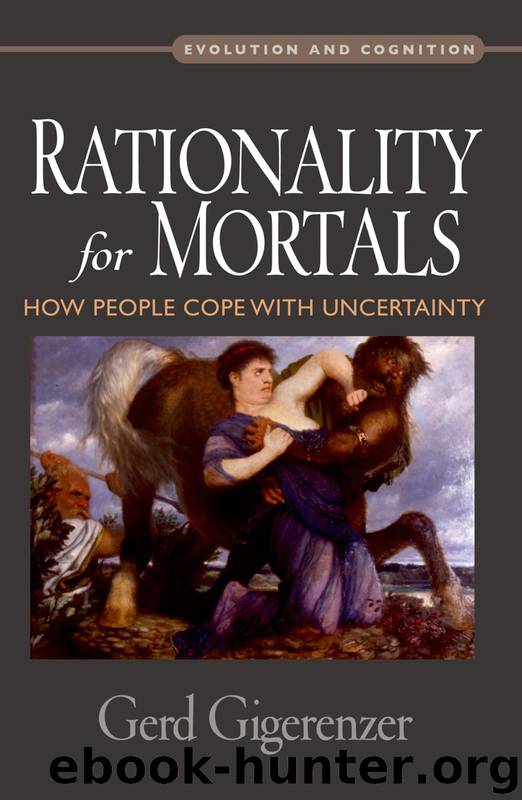Rationality for Mortals by Gigerenzer Gerd;

Author:Gigerenzer, Gerd;
Language: eng
Format: epub
Publisher: Oxford University Press
Published: 2008-04-14T04:00:00+00:00
Figure 8.1 shows that, as the correct interpretation, two-thirds of the respondents in New York chose days, about one-quarter chose time, and a few chose region. In none of the European cities, in contrast, did a majority of respondents select the days interpretation. The favored interpretation in Amsterdam, Berlin, Milan, and Athens was time.
Figure 8.1: First choice. Citizens of New York (n = 103), Amsterdam (n = 117), Berlin (n = 219), Milan (n = 203), and Athens (n = 108) were asked what the statement “There is a 30 percent chance of rain tomorrow” refers to. The three alternatives were “It will rain tomorrow for 30 percent of the time,” “in 30 percent of the region,” and “on 30 percent of the days on which the prediction is made.”
As figure 8.2 reveals, the days interpretation is polarizing. It is often judged as the best (in New York) or the worst (in the European cities) but rarely as the second-best. For instance, consider the different distributions of first and last choices among the participants in Athens. Their first choices (figure 8.1) were fairly uniformly distributed, consistent with Greeks’ lack of exposure to probabilities of rain in weather forecasts. However, it is the days interpretation (figure 8.2) that makes least sense to the participants in Athens, and the same holds for the other three European cities. As one Milanese expressed it, “A percentage of days is most absurd.” Many people thought that the forecast refers to when, where, or how much it will rain tomorrow. Figures 8.1 and 8.2 illustrate that lay interpretations of rain probability in the European cities diverge substantially from the meaning intended by meteorologists.
Does the prevalence of the days interpretation increase with a country’s length of exposure to weather forecasts that include rain probability? Figure 8.1, which orders the cities according to exposure, shows that the prevalence of the days interpretation in the five countries is not positively correlated with length of national exposure. Only the high frequency in New York fits the national-exposure hypothesis.
To test the individual-exposure hypothesis, we measured the proportion of each participant’s life during which he or she had been exposed to weather forecasts expressed in probabilistic terms. This continuous measure ranged from 0 for all respondents in Greece and Italy (where probabilistic forecasts have not been introduced into the mass media) to 1 for people who both resided in the United States, the Netherlands, or Germany (where probabilities are routinely reported in mass media weather forecasts) and who were born after probabilities of rain were introduced (e.g., for New Yorkers, after 1965). Consistent with the individual-exposure hypothesis, the proportion of individual exposure was positively related to choosing the days interpretation (r = 0.2, p = 0.0001), negatively related to choosing the region interpretation (r = –0.2, p = 0.0001), and unrelated to choosing the time interpretation (r = –0.02). Although these correlations are statistically significant, they are small in magnitude, indicating that exposure to probabilities of rain per se affords little opportunity to learn what they really mean.
Download
This site does not store any files on its server. We only index and link to content provided by other sites. Please contact the content providers to delete copyright contents if any and email us, we'll remove relevant links or contents immediately.
Cecilia; Or, Memoirs of an Heiress — Volume 1 by Fanny Burney(32029)
Cecilia; Or, Memoirs of an Heiress — Volume 3 by Fanny Burney(31441)
Cecilia; Or, Memoirs of an Heiress — Volume 2 by Fanny Burney(31391)
The Lost Art of Listening by Michael P. Nichols(7141)
We Need to Talk by Celeste Headlee(5398)
Asking the Right Questions: A Guide to Critical Thinking by M. Neil Browne & Stuart M. Keeley(5339)
On Writing A Memoir of the Craft by Stephen King(4650)
Dialogue by Robert McKee(4147)
Pre-Suasion: A Revolutionary Way to Influence and Persuade by Robert Cialdini(3962)
I Have Something to Say: Mastering the Art of Public Speaking in an Age of Disconnection by John Bowe(3765)
Elements of Style 2017 by Richard De A'Morelli(3229)
The Book of Human Emotions by Tiffany Watt Smith(3128)
Fluent Forever: How to Learn Any Language Fast and Never Forget It by Gabriel Wyner(2903)
Name Book, The: Over 10,000 Names--Their Meanings, Origins, and Spiritual Significance by Astoria Dorothy(2831)
Good Humor, Bad Taste: A Sociology of the Joke by Kuipers Giselinde(2815)
Why I Write by George Orwell(2762)
The Grammaring Guide to English Grammar with Exercises by Péter Simon(2639)
The Art Of Deception by Kevin Mitnick(2619)
Don't Sleep, There Are Snakes by Daniel L. Everett(2495)
